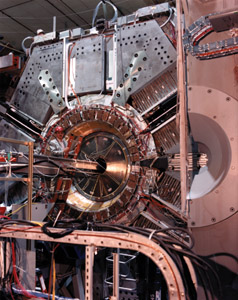
Two major new experiments have provided the first strong indications of the delicate CP violation effect in a totally new domain – the decays of B mesons (containing the fifth or “b” quark). Exploring this still unexplained phenomenon under these conditions could provide fresh insights.

The phenomenon that physicists call CP violation ultimately distinguishes matter from antimatter. In CP (charge/parity) symmetry, the physics of left-handed particles is the same as that of right-handed antiparticles – a natural enough assumption after physicists had been shocked in 1956 to discover that nuclear beta decay is spectacularly left-right asymmetric (P-violating). However, in 1964 new experiments found that CP symmetry is also flawed. Until recently, the only way to explore CP violation was via the study of the neutral kaon, where CP violation was originally discovered in 1964. However, a new generation of experiments at the PEP-II and KEKB electron-positron colliders at SLAC, Stanford, and Tsukuba, Japan, tuned to produce copious supplies of B-mesons, has opened up a new phase of CP violation research.
These “B-factory” machines achieve unprecedented collision rates for electron-positron machines (luminosities well over 1033/cm2/s). At SLAC, the BaBar detector has studied 23 million B pairs produced by PEP-II tuned to the upsilon 4S resonance. At KEK, with KEKB tuned to the same energy, the Belle detector has investigated 11.1 million B pairs. The experiments look for CP-violating B decays, mainly into a J/psi particle and a short-lived kaon. When comparing the decays of the neutral B meson and its antiparticle, CP appears as a time-dependent asymmetry in the decays to a specific CP state.
The quark transitions responsible for CP violation are conventionally described by a 3 x 3 matrix – the Cabibbo/Kobayashi/Maskawa (CKM) matrix – the rows and columns of which correspond to the six types of quark. For the B meson system, the relevant parts of this matrix are conveniently represented by a triangle, the angles of which can be measured via CP violation effects.
One of these angles, ß, or rather sin2 ß, has been measured by the new experiments. The BaBar result is sin2 ß = 0.34 ±0.20 ±0.05, while that of Belle is 0.58 + 0.32 – 0.34 + 0.09 – 0.10. (For historical reasons, the Japanese prefer to label the angle as F1.) Combined with results from other experiments, including a measurement by the CDF detector at Fermilab’s Tevatron, the world average sin2 ß = 0.49 ±0.16, which pretty much rules out (3 standard deviations) the possibility of no CP violation at all.
In reporting this development, CERN Courier has an apology to make. First indications of these B-decay CP violation measurements were announced at last year’s International High Energy Physics Conference in Osaka. These initial measurements still had rather large errors, which meant that the provisional result was still compatible (just) with no CP violation at all. CERN Courier’s report of this meeting jumped the gun when it alleged that CP violation had been “seen” in B decays.
“It is only a 1-sigma effect,” objected the physicists, who are still stopping short of announcing a discovery. For an appraisal of these latest results, see B factories measure an eternal triangle.





